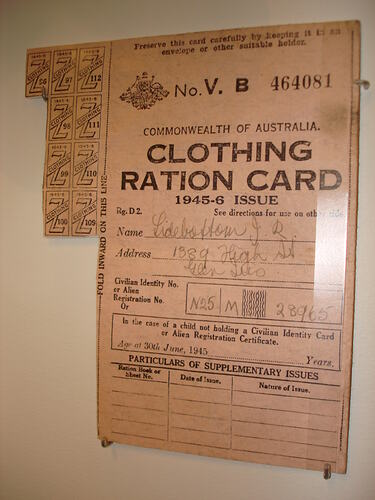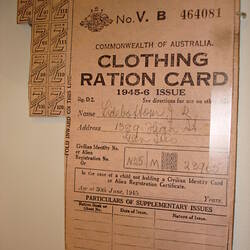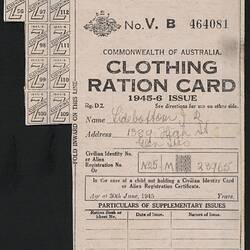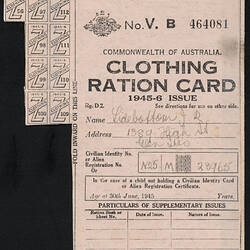Summary
Ration card for clothing, consisting of a single peach-coloured card with coupons to be cut off. Originally 24 coupons would have been included; nine remain. The card is printed '1945-6 issue'. The card was issued to J.R. Sidebottom of Glen Iris.
Shortages of foodstuffs, clothing and other products were part of life on the homefront during World War II. The first controls over the production and distribution of products were introduced in 1940, partly due to disruption of shipping. In 1942, after Japan entered the War, comprehensive rationing was introduced to manage shortages and control civilian consumption. The first product to be rationed was clothing, gazetted on 12 June 1942. Each adult was allowed 112 clothing coupons per year. Tea rationing was introduced the following month, followed by sugar, butter and then meat. After the War, rationing was gradually phased out. Clothing rationing was abolished on 24 June1948. The last rationed product was tea, which ended in July 1950.
Physical Description
Pink-coloured card, printed in black with coupons to be cut off from the left side. Nine coupons remain from the original 24 supplied.
Significance
Historic context: By early 1942, World War II was no longer a distant conflict for Melburnians. Japanese forces were advancing in the Pacific, and Australia's northern coastline was being bombed. In Melbourne, anti-aircraft guns were installed at Maribyrnong, and by mid-1942, 30 000 American troops were stationed in the city. Regulations clamped down on everyday life, controlling where people worked and what food, clothes and petrol they could buy. Even the number of football games and race meetings were restricted. Melbourne's factories ramped up production - especially those making munitions, aeroplanes, textiles and food. Because labour was scarce, women worked in new areas such as heavy industry and public transport. The war changed the economic, industrial and cultural landscape of Melbourne forever. (Melbourne Story exhibition label, 2008)
More Information
-
Collecting Areas
-
Acquisition Information
Donation from Mr William (Bill) L. Sidebottom, 30 Nov 1988
-
Printer
H.E. Daw, Government Printer, Melbourne, Greater Melbourne, Victoria, Australia, 1945
-
Organisation Named
Antarctic Division, Department of Science, Commonwealth of Australia
-
Person Named
J. R. Sidebottom, 1389 High Street, Glen Iris, Greater Melbourne, Victoria, Australia, 1945-1946
-
Inscriptions
Text: Preserve this card carefully by keeping it in an/envelope or other suitable holder/No. V.B 464081/COMMONWEALTH OF AUSTRALIA/CLOTHING/RATION CARD/1945-6 ISSUE.
-
Classification
-
Category
-
Discipline
-
Type of item
-
Overall Dimensions
119 mm (Width), 140 mm (Height)
-
Dimensions
119 mm (Length), 140 mm (Height)
Measurement From Conservation.
-
References
'Rationing of food and clothing during the Second World War', National War Memorial, [Link 1] accessed 30/1/2009 Departmental history of rationing of clothing and food, 1942-1950 (Melbourne: Commonwealth Rationing Commission, 1950) S.J. Butlin and C.B. Schedvin, War economy, 1942-1945, Australia in the War of 1939-45, vol. IV, (Canberra: Australian War Memorial, 1977): pp. 286-309
[Book] Darian-Smith, Kate. 1990. On the home front: Melbourne in wartime 1939-1945.
-
Keywords
Home Fronts, Ration Coupons, Rationing, Wars & Conflicts, World War II, 1939-1945




